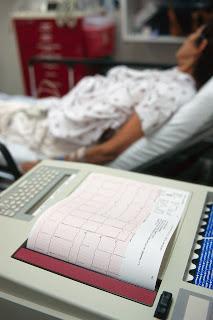
A new study by Drs. Johnson and Ackerman from the Mayo Clinic just published in the British Journal of Sports Medicine cast doubt on the current guidelines for athletes with congenital long QT syndrome (LQTS).
In a previous post, I wrote about the condition known as LQTS. You may already know that this condition comes in an inherited, or congenital, form as well as an acquired form (as an unwanted side effect of various medications). Today, we'll focus on the congenital form.
Patients--particularly young athletes--with congenital LQTS have a well-documented increased risk of sports-related sudden cardiac death (SCD). The magnitude of that risk depends upon the particular genetic defect responsible for the condition.
The latest consensus guidelines regarding athletes and heart disease were published in the United States in 2005 as Proceedings from the 36th Bethesda Conference and in that same year by European Society of Cardiology (ESC). To summarize these guidelines in a nutshell....
Bethesda Guidelines
1. Athletes should be limited to low-intensity sports (eg, billiards, bowling, cricket, curling, golf, riflery) if they have LQTS: with any symptoms; if the QTc is >470 msec for males or >480 msec for females; or if they have an internal cardioverter-defibrillator (ICD).
2. Athletes who are proven gene carriers for LQTS but who have no symptoms are allowed to participate fully in their sports.
ESC Guideline
1. Athletes with LQTS, regardless of the presence or absence of symptoms, are disqualified from participating in any sports.
In the new study, the investigators reported on their experience with 353 patients age 6 to 40 with long LQTS who were evaluated initially between 2000 and 2010. The majority of these patients--223--were not involved in sports or chose not to pursue their sports after their disease ws diagnosed. The focus of the study was on the remaining 130 athlete-patients: 60 male and 70 female athletes; 20 had an ICD.
Among the 130 athlete-patients, 70 were asymptomatic (participating in sports contrary to the ESC guidelines but within the Bethesda guidelines). The remaining 60 were symptomatic (and were participating in sports contrary to both sets of guidelines).
In follow-up that averaged 5.5 +/- 3.4 years, the authors reported that there was only 1 adverse event among the 130 athlete-patients--in one of the symptomatic patients (age 9) with an ICD who had an appropriate shock for a potentially fatal arrhythmia. Among the asymptomatic patients, there were no adverse events.
Conclusions and Implications
1. It's important to remember that the vast majority of athlete-patients in this study were children and the findings may or may not extend to adult athletes with LQTS. Further investigation is needed in the adult athlete population with LQTS.
2. The current Bethesda and ESC guidelines for LQTS may be too restrictive, given the findings among the athlete-patients who continued their sports contrary to the 2005 guidelines. In this study, these patients rarely had adverse events.
3. It is still important for careful discussions regarding risk stratification (which may depend upon the precise genetic defect) and consideration of all treatment options before making decisions about continued participation in sports.
Related posts:
1. Long QT syndrome
2. Index to all of the posts at AthletesHeart through 2012
